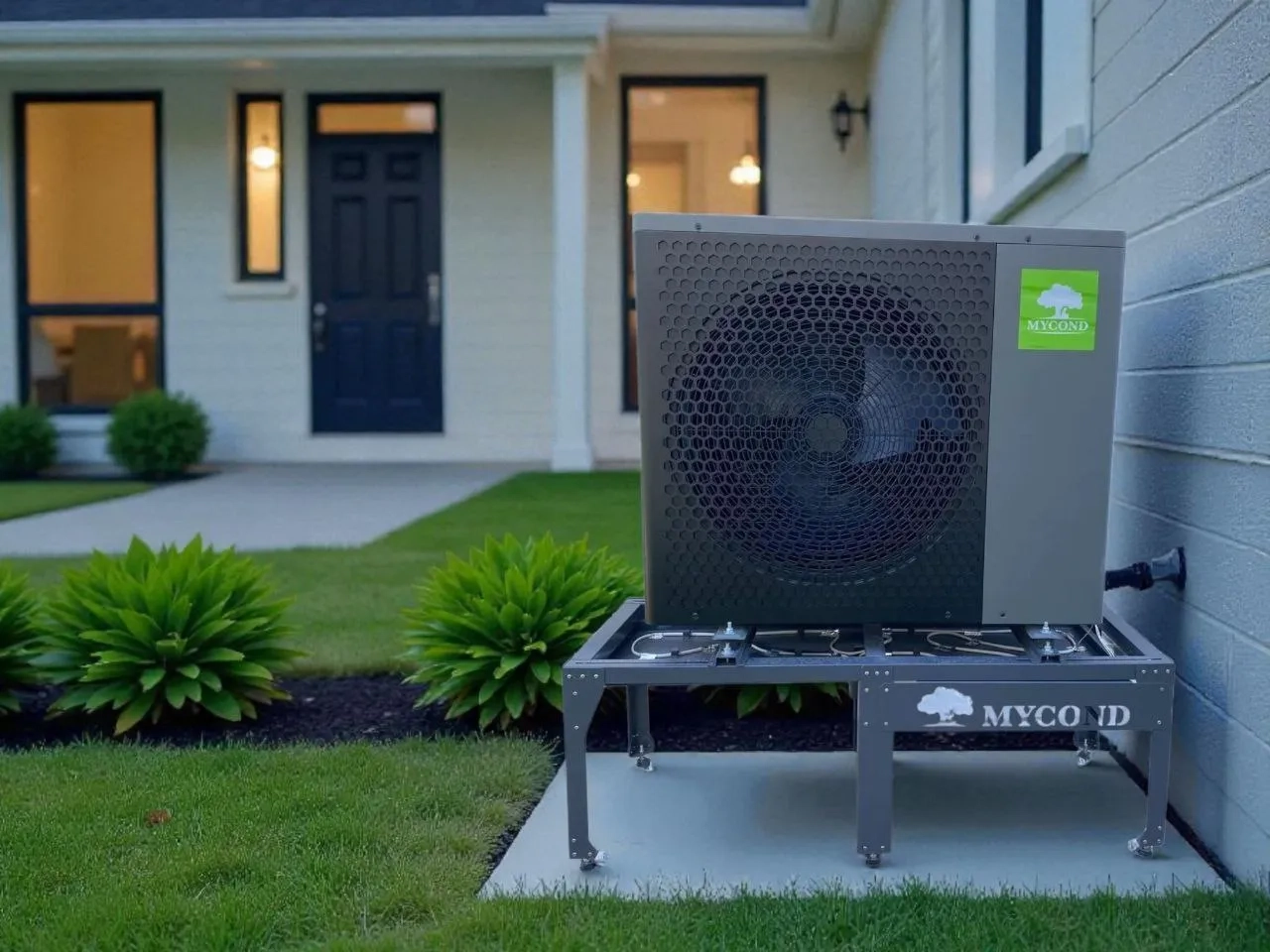
Homeowners of 120–240 m² in the United Kingdom increasingly face a difficult choice: modernise the existing heating system or install a new one. Volatile gas prices, stricter environmental standards in Britain, and the need for cooling during hot summer months in London, Manchester or Birmingham turn the selection of an optimal heating system into a serious engineering task.
Traditional gas boilers have been the standard in the UK for decades, but heat pump technologies are rapidly evolving. Which system is actually more advantageous and efficient from an engineering standpoint for the British climate?
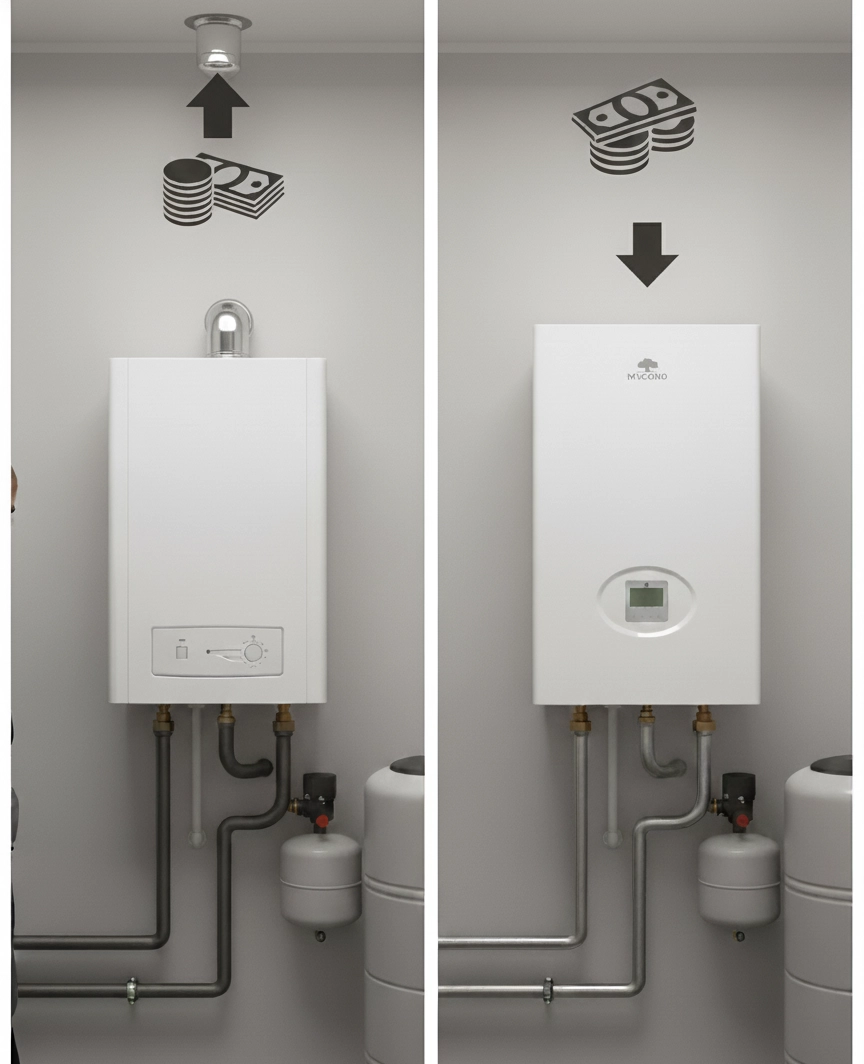
How both technologies work
Gas condensing boiler operates on the principle of burning gas to heat the heat transfer fluid. Modern condensing boilers utilise additional heat from the condensation of water vapour contained in the flue gases, achieving efficiencies of up to 98%. However, their operation directly depends on gas supply and requires regular maintenance.
Air-to-water heat pump works on a different principle. Instead of burning fuel, it uses electricity to transfer thermal energy from the ambient air into the home’s heating system. This process provides significantly higher efficiency: for 1 kW of electricity consumed, 3–5 kW of thermal energy is produced. Heat pump efficiency is measured by the COP (Coefficient of Performance), and seasonal efficiency by the SCOP (Seasonal Coefficient of Performance).
Methodology for technical comparison
For an objective comparison of heating systems across different climatic conditions in the UK, several key parameters must be considered:
- Heat pump COP/SCOP: efficiency at different operating points (A7/W35 means air temperature 7°C and water temperature 35°C).
- Gas boiler efficiency: efficiency of condensing boilers (up to 98%) versus conventional ones (82–85%).
- Seasonal efficiency: SCOP of heat pumps accounts for efficiency variation throughout the season.
- Dependence on outdoor temperatures: heat pump efficiency decreases as the outdoor temperature drops.
- Operating modes: heating, domestic hot water, cooling.
Efficiency comparison across temperature ranges
| Outdoor temperature | Heat pump efficiency (COP) | Gas boiler efficiency |
|---|---|---|
| +10°C | 5.0-5.2 (100%) | 95-98% (100%) |
| +7°C | 4.5-4.9 (90-95%) | 95-98% (100%) |
| 0°C | 3.8-4.2 (75-82%) | 95-98% (100%) |
| -7°C | 2.9-3.1 (58-63%) | 95-97% (98-99%) |
| -15°C | 2.5-2.8 (48-55%) | 94-96% (97-98%) |
| -25°C | 2.0-2.6 (40-50%) | 93-95% (95-97%) |
As we can see, the efficiency of gas boilers remains fairly stable as temperatures fall, whereas heat pump efficiency decreases. However, even at -25°C, modern heat pumps maintain a COP above 2, which equates to 200% efficiency compared with direct electric heating.
Technical specifications of Mycond BeeHeat
The Mycond BeeHeat series includes models with different outputs and efficiencies, allowing you to choose the optimal solution for homes of any size in the UK:
| Model | Output, kW | COP at A7/W35 | COP at A-7/W35 |
|---|---|---|---|
| MHS-N6BH/U6BH | 6.0 | 4.89 | 2.94 |
| MHS-N8BH/U8BH | 7.9 | 4.51 | 3.05 |
| MHS-N10BH/U10BH | 9.7 | 4.62 | 3.1 |
| MHS-N12BH/U12BH | 12.1 | 4.51 | 2.7 |
| MHS-N14BH/U14BH | 14.3 | 4.61 | 2.7 |
| MHS-N16BH/U16BH | 16.2 | 4.41 | 2.6 |
Additional features of the BeeHeat series:
- Operating temperature range: -25...+43°C
- Flow temperature: up to +60°C
- Refrigerant: R32 (environmentally friendly with low GWP 675)
- Energy efficiency class: A+++ (W35) and A++ (W55)
- Sound level: 42 dB(A) indoor unit, 58-68 dB(A) outdoor unit
- Power supply: 230/50Hz (up to 10 kW) and 400/50Hz (from 12 kW)
- Cooling mode: EER 2.45-2.94
BeeHeat models are equipped with Mitsubishi inverter technology, enabling smooth power modulation according to heating demand, and a high-efficiency Alfa Laval plate heat exchanger for maximum heat transfer.
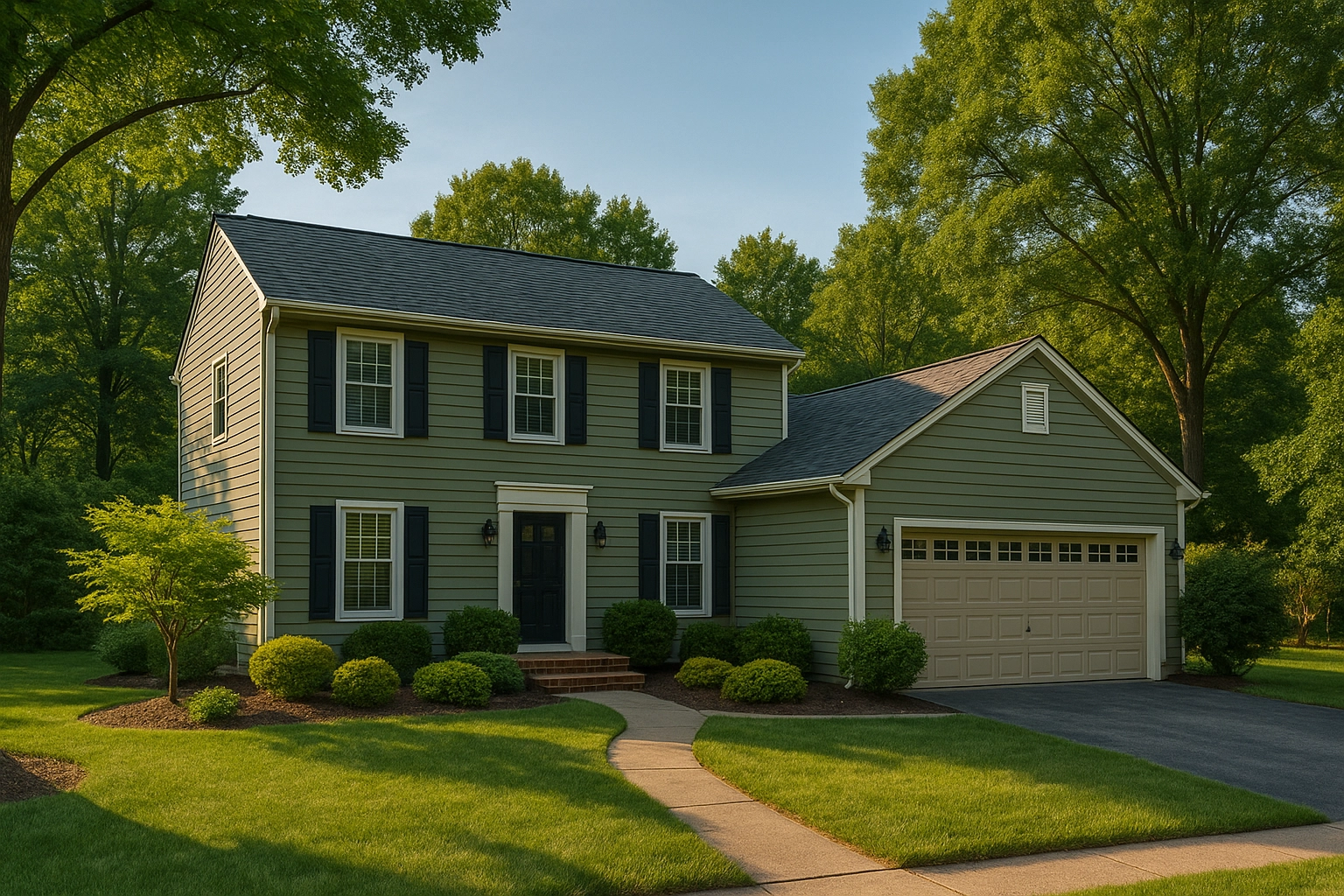
Checklist for choosing between a heat pump and a gas boiler
- Availability/cost of connection to the gas grid: in the absence of, or with high connection costs to, the gas grid, a heat pump has the advantage.
- Floor area and heat losses: for highly energy-efficient homes (50-70 W/m²), heat pumps operate with maximum efficiency.
- Type of heating system: heat pumps are most efficient with low-temperature systems (underfloor heating, fan coils), whereas gas boilers work well with radiator systems.
- Need for summer cooling: the BeeHeat heat pump provides cooling without additional equipment.
- Climatic zone: in the mild climate of London, Manchester and most regions of the UK, heat pumps operate with high efficiency.
- Cascade connection capability: BeeHeat allows up to 9 units to be connected for larger sites.
- Noise level: in high-density British urban areas, it is important to consider the outdoor unit’s noise level.
- Environmental requirements: heat pumps have significantly lower CO₂ emissions, which is important for UK environmental policy.
- Integration with "smart home": both systems can be integrated, but Mycond heat pumps offer advanced control capabilities.
- Stability of electricity supply: stable power supply is required for heat pump operation.
When it makes sense to choose BeeHeat
The Mycond BeeHeat heat pump is the optimal solution in the following cases:
- New build with underfloor heating/fan coils: at a flow temperature of 35–45°C, a maximum COP of 4.4–4.9 is achieved, delivering the highest efficiency.
- Modernisation with bivalent operation: the ability to use BeeHeat together with an existing boiler as backup at low temperatures.
- Homes requiring cooling: one system provides both heating and cooling with EER up to 2.94.
- Regions with a temperate climate: in a typical British climate with average winter temperatures above -10°C, high seasonal SCOP is ensured.
- Sites without access to the gas grid: for remote areas of Scotland or rural locations where gas grid connection is difficult.
- Projects with environmental certifications: systems with energy efficiency class A+++, low CO₂ emissions and environmentally friendly R32 refrigerant.
An important advantage of BeeHeat is the ability to switch automatically to a backup heat source at critically low temperatures, ensuring heating system reliability even on the coldest days of a British winter.
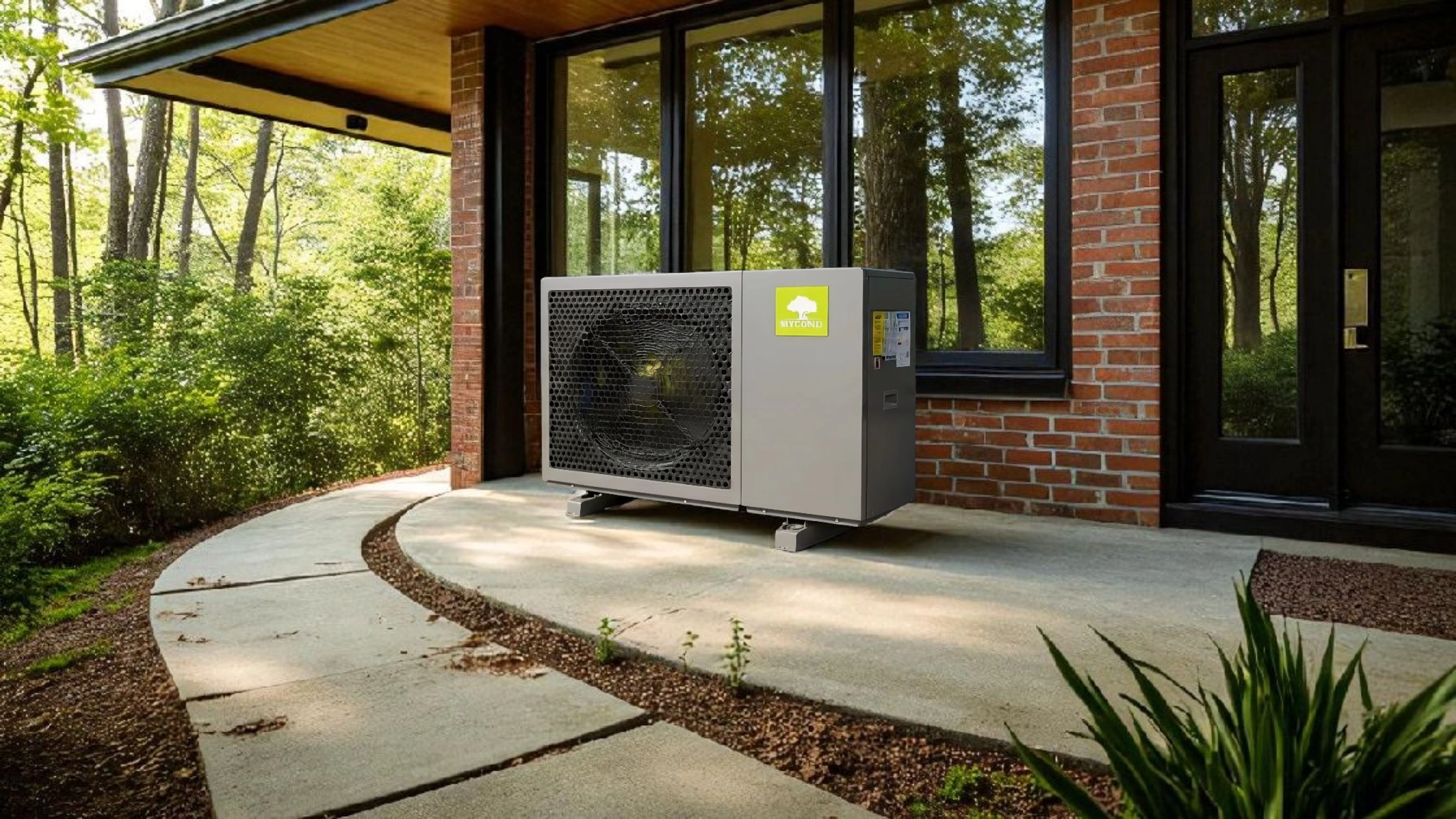
Alternatives and comparisons within the Mycond range
Other solutions are also available in the Mycond portfolio for heating homes in the UK:
- BeeEco: monoblock with R290 refrigerant, flow temperature up to +75°C, energy efficiency class A+++ at W55 – optimal for radiator system retrofits.
- BeeSmart/Arctic Home Smart: split system with output of 9.2–18.5 kW, flow temperature up to +55°C – for medium-sized sites.
| Feature | BeeHeat | BeeEco |
|---|---|---|
| System type | Split | Monoblock |
| Flow temperature | up to +60°C | up to +75°C |
| Installation specifics | Compact outdoor unit, certified refrigerant installer required | Simpler installation without a refrigerant line |
| Optimal application | New projects with low-temperature systems | Retrofit with radiator systems |
The BeeHeat split system is appropriate where the compactness of the outdoor unit and a reduced risk of the heat transfer fluid freezing are important. The BeeEco monoblock is preferable if there is no access to certified refrigerant specialists or a high flow temperature is required for older radiator systems.
Installation, operation, integration
BeeHeat is a split system with an indoor hydronic module that includes:
- Shimge circulation pump
- 5 l expansion vessel
- Alfa Laval plate heat exchanger
- Built-in electric heater
Connection requirements depend on output: 230 V for models up to 10 kW and 400 V for higher-power models from 12 kW. The system integrates easily with different heating types: radiators, underfloor heating and fan coils.
Users get access to the Mycond App for remote control, the ability to connect a room thermostat, weather-compensated control and a "night mode" with reduced noise – particularly relevant for the dense urban fabric of British cities.
Comparison of maintenance requirements:
- Heat pump: minimal maintenance, no annual flue inspection
- Gas boiler: mandatory annual service, cleaning, and flue inspection in accordance with UK regulations
Calculating the bivalent point
The bivalent point is the temperature at which it becomes more advantageous to switch from the heat pump to a backup heat source, such as a gas boiler. Its calculation considers the decrease in the heat pump’s COP as the outdoor temperature drops.
For a typical house in London with an MHS-N10BH/U10BH heat pump (COP 4.62 at A7/W35 and 3.1 at A-7/W35) and a condensing gas boiler (97% efficiency), the bivalent point lies in the range of -7...-10°C.
The graph of COP versus outdoor temperature shows that at temperatures below the bivalent point, the efficiency of using a gas boiler becomes higher. The BeeHeat system has an automatic switchover function to the backup heat source, ensuring optimal operation.
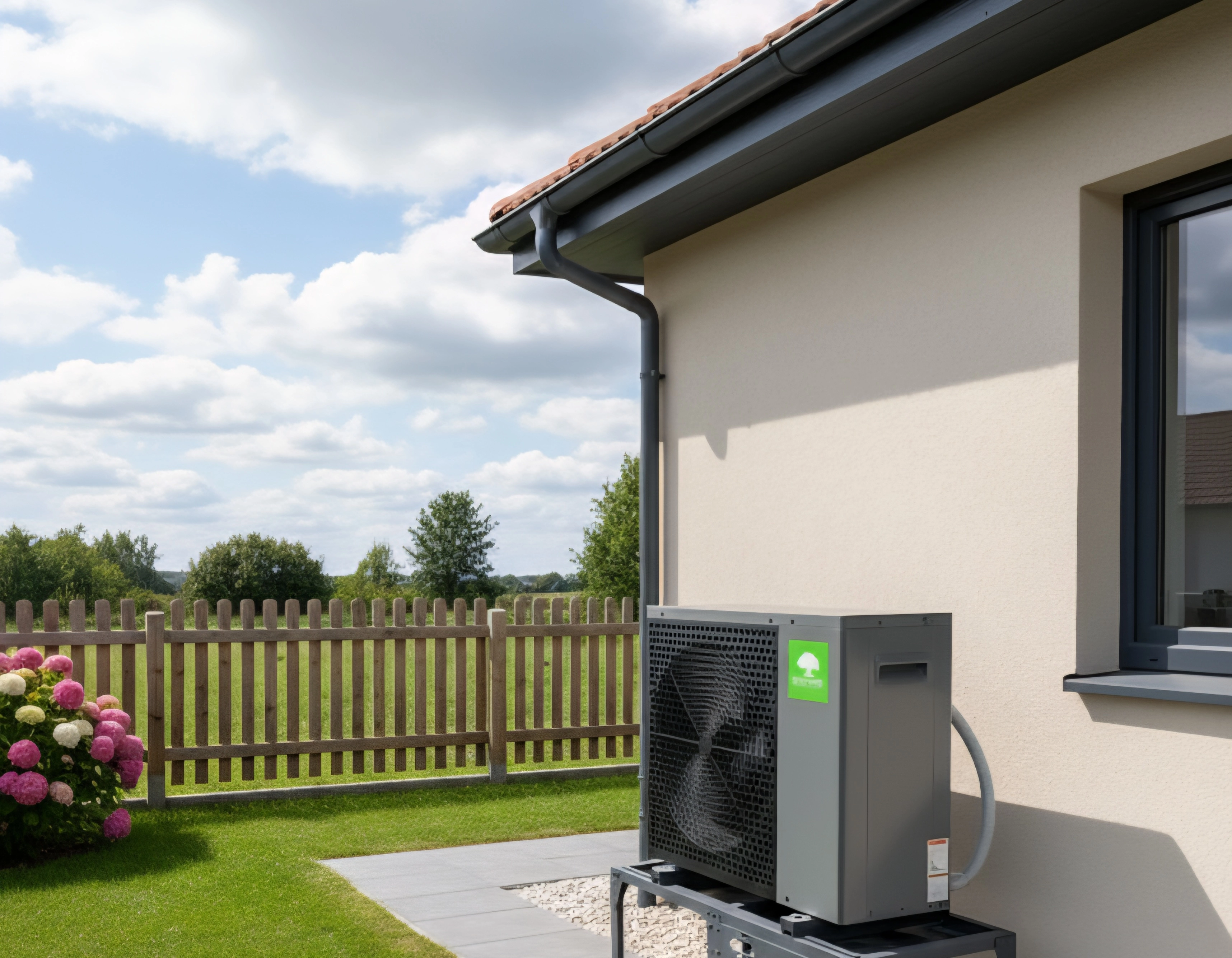
Frequently asked questions (FAQ)
Can the BeeHeat heat pump be used at -25°C?
Yes, BeeHeat’s operating range is -25...+43°C, but it is important to note that at low temperatures the COP drops to 2.6–3.1, which still provides higher efficiency compared with direct electric heating.
What is BeeHeat’s flow temperature?
The flow temperature of the heat transfer fluid in the BeeHeat system reaches +60°C, which suits most heating systems in the UK, including low-temperature radiators.
How much electricity does a heat pump use?
Heat pump electricity consumption depends on COP. At COP 4.0, for every 1 kWh of electricity consumed, 4 kWh of heat is produced. For example, to deliver 10 kW of heat, the pump will draw approximately 2.5 kW of electrical power at COP 4.0.
Is a backup boiler required?
A backup boiler is recommended for colder regions of the UK, especially in northern Scotland, or as a reserve during extremely low temperatures. BeeHeat has an automatic switchover function to the backup source.
What is the BeeHeat noise level?
The noise level is 42 dB(A) for the indoor unit and 58–68 dB(A) for the outdoor unit. For comparison, a quiet office has a noise level of around 40 dB(A). The "night mode" function further reduces noise levels.
Can BeeHeat be used for cooling?
Yes, BeeHeat provides cooling with an EER of 2.45–2.94 within a temperature range of +8...+43°C, which is particularly relevant during summer periods in London, Birmingham and other British cities.
Heating system selection consultation
To choose correctly between a heat pump and a gas boiler, the individual characteristics of your home must be taken into account. Mycond engineers can provide a free consultation to select the optimal heating system for your property in the UK.
The consultation includes calculating the bivalent point for your region, selecting the optimal BeeHeat model according to heat load and heating system type. You will also receive information about Mycond’s technical support and service in the UK.
To request a consultation, contact Mycond experts via the feedback form on the website or call the listed number.